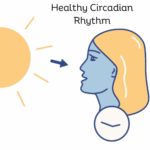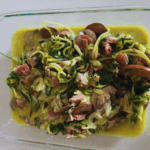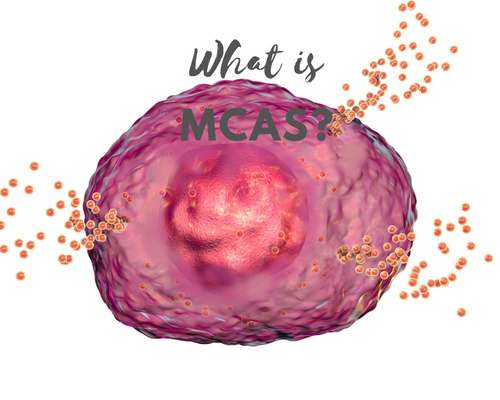This post is a primer on symptom logging. If you have Mast Cell Activation Syndrome (MCAS) you will likely have a list of foods that you can’t tolerate. You may have a puzzling history of reacting to certain foods in certain circumstances. But you may not have a clear idea of why. By logging your symptoms, and ideally introducing one new food or environmental trigger at a time, you can narrow down the cause of symptom flares.
As an Amazon Associate, I earn from qualifying purchases.
Table of Contents
What is MCAS?
Mast Cell Activation Syndrome (MCAS) is a chronic condition that affects all organ systems. MCAS is serious and disabling and people with MCAS experience often significant and debilitating symptoms daily, including anaphylaxis, which can be fatal.
MCAS is often found in combination with other chronic conditions such as Ehlers-Danlos Syndrome (EDS) and Postural Orthostatic Tachycardia Syndrome (POTS).
Frequently healthcare providers do not know about MCAS, and the tests for MCAS are problematic because they are not uniformly reliable. MCAS can be difficult to manage. Treatments include blocking mast cell mediators with anti-histamines and mast cell stabilizers, as well as avoiding triggers.
Check out this post on how to manage MCAS.
Benefits of symptom logging
One of the best ways to begin to figure out your food triggers is to keep a symptom and food diary. Start with a list of your most bothersome symptoms, and track those symptoms against what you ate. It can sound daunting, but here is a simple example:
| Symptoms | 6/5/22 | 6/6/22 | 6/7/22 |
| Bloating | X | X | |
| Joint pain | X | ||
| Migraine | X | X | |
| Tachycardia | X | ||
| New or suspect foods | Cottage cheese | Salad dressing | Avocado |
The bucket theory
The bucket theory offers a helpful analogy for understanding symptom reactions with MCAS.
Think of your body as an empty bucket that you want to keep from overflowing. Different foods and activities fill your histamine bucket at different speeds but they combine to form the total level of histamine in your body (how full your bucket is). A fuller bucket means you have more histamine symptoms. When you manage triggers, reduce exposure to known triggers, and take medications and supplements to reduce histamine, you can manage the level of your bucket.
Do you know your typical symptom progression?
One of the keys to understanding the level of your bucket is knowing your symptom progression. It is helpful to keep track of the symptoms you are having and to evaluate whether they are escalating. Symptom escalation means that the level of your bucket is rising.
Knowing your symptom progression in a symptom flare is the key to developing your own rescue plan. In this post, I discuss how to determine your own symptom progression. Once you know what typically happens in your symptom progression you can design a rescue plan to address those symptoms.
Get my free ebook, symptom log, and meal plan!
Want a tool to keep track of your symptoms easily? Sign up for my newsletter and you will receive my free 50-page ebook of lower-histamine, grain-free, sugar-free recipes, my free symptom log, and a free two-week meal plan!
Symptom logging tolerated foods
At the same time keep a list of foods that you can tolerate, your “maybe” foods, and those that you are pretty sure you can’t tolerate.
| Tolerated | Maybe | Not tolerated |
| Cassava flour | Avocado | Vinegar |
What to eliminate
Typically it is helpful to begin by eliminating all foods high in histamine first (see the list of POSSIBLE FOOD TRIGGERS and the list of GENERALLY TOLERATED FOODS below). Then you can gradually add individual foods back into your diet one at a time, while you keep track of the symptoms you experience when you eat just that food.
It is helpful to leave room on your symptom chart to add new symptoms or ones you forgot to add. If you try something and don’t react to it (like with the Avocado in the example above), you can put it into the “Maybe” category, pending further trials. After trying a possible trigger food you want to wait a few days before tryig it again. Then after a few times of not reacting to the possible trigger food, you can move it to the “Tolerated” category.
Possible MCAS food triggers
- Unfiltered Tap Water (chlorinated, heavy metals)
- Caffeine & Alcohol (DAO inhibitors)
- Charred/ Burnt Food (especially animal meat/skin)
- Leftovers, Aged foods, Fermented foods, Pickles, Preserves, Olives
- Vinegar (especially rice vinegar)
- Soy Sauce and Soy Products
- Shellfish (Crabs, Prawns, Shrimp, Lobster, Crayfish, Squid, Calamari, Octopus, Mussels, Clams, Oysters, Scallops)
- Bananas
- Citrus Fruit
- Avocado
- Eggs
- All Legumes
- Spicy Food
- Sugar Substitutes
- Salicylates (stevia, etc)
- Oxalates, Salicylates, Lectins
- Additives (colorants, flavors, gums, Sulphites, Preservatives such as Sodium Benzoate)
- Glyco-phosphates in non-organic vegetables
- Gluten
- Nightshade Family vegetables (Tomato, Eggplant, Potatoes, Goji Berries, Peppers)
- Strawberries, Raspberries, Pineapple, Pears, Kiwi Fruit, Papaya
- Nuts (especially peanuts, walnuts, and cashews)
Exercise caution with questionable foods
But it’s best not to consider a food tolerated until you have tried it a few times under different circumstances. What you react to today, for example, when you might be experiencing extra stress, you might not react to when your bucket is less full. So the best tactic is to take a patient trial-and-error approach to determine which foods you can tolerate and to try them one at a time to eliminate as many other variables as you can.
Sign up for the SSP!
The Safe and Sound Protocol (SSP) is a listening therapy based on Polyvagal Theory that helps heal nervous system regulation. Many people with MCAS have nervous system dysregulation stemming from infections, toxic exposures, concussions, and trauma. The SSP is an easy-to-use app where you listen to specially filtered music for 30 minutes each day for a 5-hour cycle. Studies show the SSP has a profound effect on mental health and chronic conditions
You can sign up for the SSP here!
Order my book!
Rocks and Roots chronicles my journey solo backpacking the Superior Hiking Trail and overcoming nervous system dysregulation, gut dysbiosis, and Mast Cell Activation Syndrome symptoms to hike 328 miles successfully.
Check out this powerful frequency device
Healy is an individualized microcurrent device I use to reduce inflammation. Check out this post for more about Healy.
Sign up for a session!
I provide one-on-one in-person and remote chronic illness and caregiver coaching and Sacred Self-Healing Sessions based on the Sacred Self-Healing Method, a proven novel co-creative healing modality detailed in my Books.
Click here for more information.
What do you think?
I’d love to have your reply below!
Disclaimer
The preceding material does not constitute medical advice. This information is for information purposes only and is not intended to be a substitute for professional medical advice, diagnosis, cure or treatment. Always seek advice from your medical doctor.

| ReplyForwardAdd reaction |




